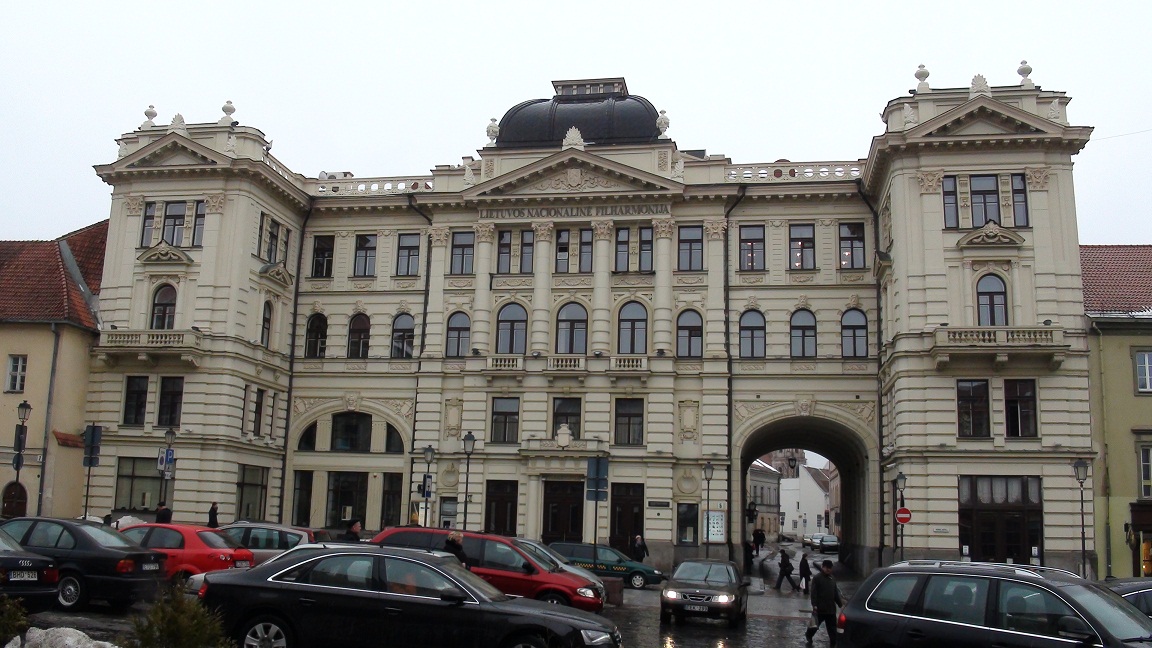Historicism and Art Nouveau in Lithuania (1860 – 1930)
Late 19th century brought the emulation of various older architectural styles to the Lithuanian soil such as neo-Gothic, neo-Romanesque, neo-Renaissance or a mix thereof. This emulation is now known as historicism and it dominates the so-called “New towns” (“Naujamiestis”) of the main cities.
These were the times of the Imperial Russian rule when even the Lithuanian language was banned. Unlike the neighboring Latvia Lithuania was envisioned by czar as a rural backwater. Therefore the “New towns” in Lithuanian cities are compact and most of their buildings are smaller in size than their counterparts in Riga or the main European capitals. That said, the late 19th century doubled the population of many cities and the new buildings were still larger than most of what was built in Lithuania ever before.

National Concert Hall in Vilnius Old Town (1902) combines various historical styles. ©Augustinas Žemaitis.
Together with historicist architecture came the new urbanistic ideas of wide straight streets (such as Gedimino Avenue in Vilnius) and symmetrical city plans. An example of pre-planned town from this era is Zarasai which follows a semicircular plan; Naujamiestis district of Kaunas is laid in a rectangular street plan.
Straight 2 km long Gedimino Avenue in Vilnius. ©Augustinas Žemaitis.
You can see monumental (in Lithuanian scale) historicist and art nouveau (also known in German as jugendstil) architecture in the Naujamiestis district of Vilnius. Entire downtown of Ukmergė was rebuilt by these styles after being consumed by fire in 1877. These styles are also prevalent in the Klaipėda Old Town, rebuilt after a major fire in 1854.
A 19th cnetury interior of the Writer's guild, originally a 19th century nobility palace in Vilnius. It shows extremely elaborate details 'borrowed' from the style of days gone-by, in this case mostly Baroque. ©Augustinas Žemaitis.
Due to the relaxation of anti-Catholic policies in early 20th century, many small towns and villages have massive historicist churches with Gothic revival being the most common style. Churches of Anykščiai, Švėkšna, Rokiškis or Palanga are good examples of this - but there are countless more.
A gothic revival church in Kupiškis, Aukštaitija region (1914). ©Augustinas Žemaitis.
Russian Orthodox churches, of which 98 have been constructed in 1863-1864 alone, were all Byzantine revival (then-official style). Secular architecture, on the other hand, favored Neoclassical, Renaissance and Baroque inspirations.
Kaunas Sobor, built for the local Russian garrison. ©Augustinas Žemaitis.
Art nouveau/jugendstil was a style unique to late 19th and early 20th century with curved lines and décor of plants. It was meant to become an antithesis for historicism. Art nouveau provided new ideas while historicism basically only emulated what had been previously created. However in Lithuania art nouveau gained quite a little foothold and never surpassed historicism (unlike in Riga for example). While rare in stately buildings, art nouveau is more common among what were once private urban detached homes of the bourgeoisie, called “urban villas”.
Art nouveau urban villa of Anton Filipowicz in Vilnius (1903). ©Augustinas Žemaitis.
Another heritage of this era, partly overlapping with Gothic revival, is the so-called “Brick style”. In these buildings bricks (brown or red) are left openly visible on the façade. Instead of creating elaborate plaster details the bricks themselves are joined together in such a way that they would look as an artistic decoration.
In Lithuania Minor where German influence was always strong, the German national romantic style (heimatstil) prevailed in the early 20th century. Its unplastered red brick walls are adorned with tall arched windows, creating an illusion of sturdy medieval constructions.
Former German military barracks (1907) in Klaipėda Naujamiestis, now housing Klaipėda University. German national romantic style. ©Augustinas Žemaitis.



Leave a comment